
How Girl Scout cookies captured the heart of America
Thin mints, Samoas, and more, explained.
By
Rachel Sugar
Jan 24, 2019, 1:00pm EST
Share
Tweet
Share
Share
How Girl Scout cookies captured the heart of America
tweet
share

It is January, which means Girl Scout cookie season 2019 has officially begun, an annual tradition in which brigades of girls in earth-toned uniforms hawk boxes of cookies to family, friends, and strangers. But unlike most fundraising efforts — National Public Radio, for example, or elementary school wrapping paper sales — Girl Scout Cookies are beloved. They are beloved like apple pie is beloved, or puppies.
Girl Scout Cookies are a triumph: of marketing, of cookie baking, of youthful entrepreneurship. Between February and April every year, Fortune recently reported, the more than 1 million scouts in the US sell about 200 million boxes of the cookies. It is an $800 million business. How much is that, in cookie terms? It’s more than Oreos, Fortune says. It’s more than Chips Ahoy and Milano sold combined. It is a staggering number of cookies. For general comparison’s sake, the entire population of America is only 325.7 million. Are we that excited about young women selling things? Are Trefoils that good? What is going on?
To unpack this mystery, let’s begin with the very basic facts.
The basic facts of Girl Scout cookies
Toward a history of Girl Scout Cookies, homemade sugar cookies to S’mores
The recorded history of Girl Scout cookies dates back to 1917 — five years after the organization was founded — when a troop of Girl Scouts in Muskogee, Oklahoma, held a cookie sale in their high school cafeteria as a way to fund troop activities. But the original cookies were home-baked, just regular cookie-cookies. Word spread; a troop in Connecticut started selling, and then a troop in Massachusetts.
In July 1922, the American Girl magazine published a recipe for basic sugar cookies, intended for troop sales. It’s a pretty simple recipe: butter, sugar, flour, eggs. Ingredients cost between 26 and 36 cents and would yield six or seven dozen cookies, which, the publication suggested, could be sold door to door for 25 to 30 cents per dozen.
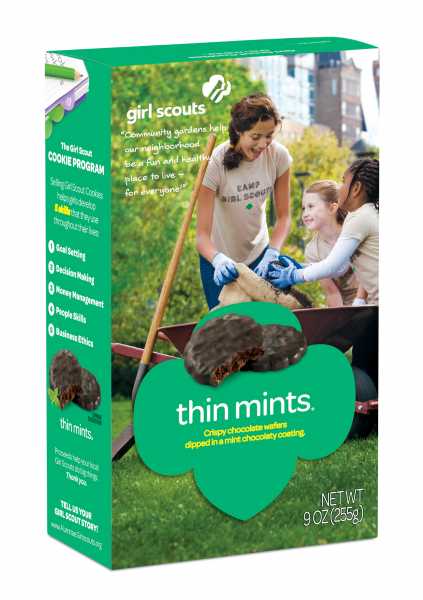
As Atlas Obscura points out, the simplicity was important since the scouts were baking the cookies themselves. But even back in the bootstrapping olden days, older and savvier relatives may have been involved. “Grandma used to bake the cookies,” a then-83-year-old former Girl Scout told Time. “I was never the kitchen cooker, I stayed outside.”
The era of home baking didn’t last long: In 1934, the Girl Scouts of Greater Philadelphia Council sold the first commercially baked version. Two years later, the national Girl Scout organization switched to commercial bakers, and that was the end of the Girl Scout baking era. In 1939 — a historic year for cookies — the Girl Scouts introduced the “first-ever iteration of the Thin Mint, then called ‘Cooky-Mints,’” Time says, noting that in the years that followed, the trim mint-chocolate cookies went by a whole roster of minty names, including Chocolate Mint, Thin Mint, Cookie Mint, and then Chocolate Mint (again), Thin Mints, Thin Mint (singular!), and then back to Thin Mints once more.
(There was a brief cookie hiatus during World War II, when flour, sugar, and butter shortages led the scouts to pivot away from cookies and toward calendars, but one of the less heralded perks of the war’s end was that they were able to return to cookies.)
By 1951, the basic cookie lineup had been finalized, reports Smithsonian: a sandwich cookie, a shortbread cookie, and a Thin Mint/Thin Mints/Chocolate Mint variety, which is still the No. 1 best-seller, probably because it is the best.
At one point in the late ’40s, there were 29 different bakeries making Girl Scout cookies. But by the ’60s, the Girl Scouts trimmed their team of licensed bakers to 14, for the sake of cookie continuity. By the late ’70s, they were down to four, and by the 1990s, the Girl Scouts had winnowed the field again, to two.
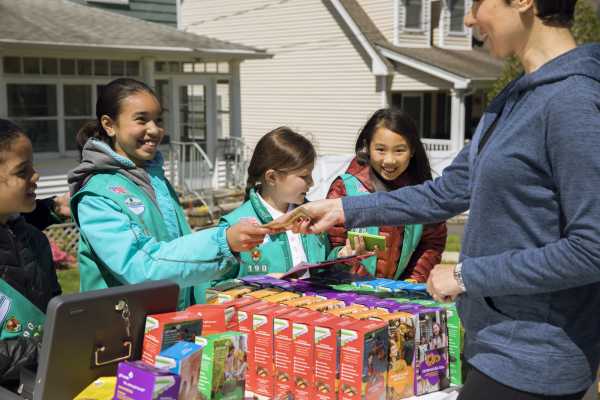
Not all cookies have been lasting hits. Shortbread (also known as Trefoils) and Thin Mints are enduring classics. Other cookies have been lost to time. Kookaburras — the “lovechild of a Rice Krispies treat and a Twix bar,” recalls a wistful Mental Floss article — came and went in the ’80s. Golden Yangles, an experimental cheese cracker, was excised from the lineup in 1992.
“The decision about cookie varieties for each Girl Scout Cookie season is a response to consumer trends and feedback, as well as sales,” Stewart Goodbody, director of communications Girl Scouts of the USA, told the Washington Post. The reduced-fat Apple Cinnamons and Olé Olés of the ultra-low-fat ’90s are a relic of their era; now we have Toffee-tastics and, this year, Caramel Chocolate Chip Cookies, both of which are gluten-free.
Which cookies you get — and what those cookies taste like — depends on where you live
Today, Girl Scout cookies are produced by two bakeries: ABC Bakers and Little Brownie Bakers. This is why near-identical cookies have different names — why some people know chocolate-striped coconut-caramel rings as “Samoas” (a product of Little Brownie Bakers) and others know them as “Caramel deLites” (a product of ABC Bakers).
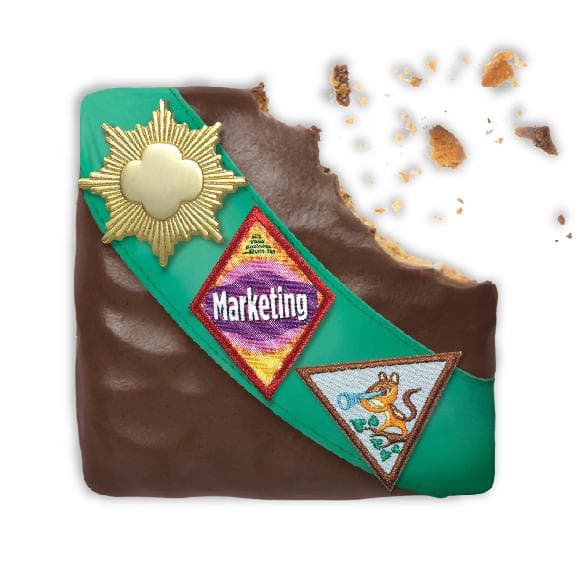
In Detroit, you get Tagalongs, Little Brownie’s entry into the peanut butter/chocolate cookie canon. But in Chicago, you get Peanut Butter Patties, by ABC Bakers, instead. Are the cookies the same? In spirit, yes. In reality, there are slight variations in the recipes, apparent on the nutritional panel, and also by looking at it. Even cookies that go by the same name nationwide — a Thin Mint is always a Thin Mint — taste different depending on who makes them.
The Los Angeles Times, which has meticulously tracked the geographic differences between cookies, explains that an ABC Bakers Thin Mint is “crunchier, with more mint than chocolate in each bite,” while the Little Brownie Bakers cookie — still a Thin Mint! — has a “richer smoother chocolate coating” with a “distinct peppermint taste.” Or consider the S’mores cookie, a 2017 addition to the Girl Scout cookie canon, which is, in fact, two distinct cookies that share one name.
According to the New York Times, the GSUSA presented the idea for the S’more to both bakeries, which created their own cookie-fied versions of the campfire classic. (As the Girl Scouts’ FAQ cookie page says, “There’s no wrong way to eat s’mores!”) The ABC S’more, per the LA Times analysis, is a chocolate-covered square with a “faint vanilla/marshmallow layer” and a larger graham cracker portion. The Little Brownie variation, however, is a blond-looking sandwich cookie filled with a layer of chocolate and another of “marshmallowlike icing,” printed with the clarifying words “Girl Scout S’mores.”
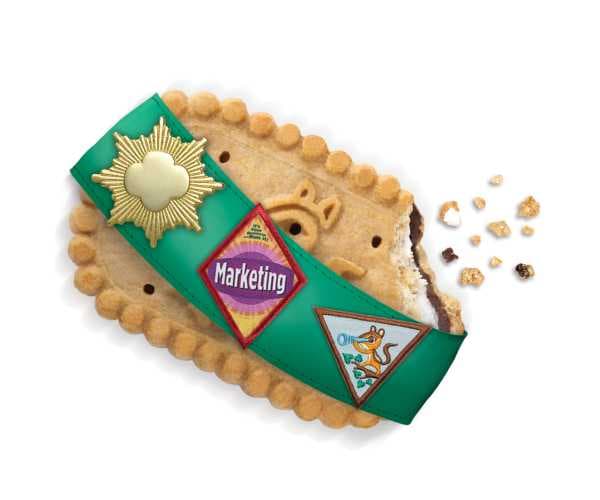
Some cookies, meanwhile, are only available through one baker or the other. There is no exact Little Brownie equivalent of ABC’s Thanks-a-Lots, shortbread rounds with fudge bottoms, and no precise ABC interpretation of Little Brownie’s gluten-free Toffee-tastic cookies, although this year, ABC launched its own gluten-free offering, a caramel chocolate chip melange. Each baker, a Girl Scout spokesperson told the Washington Post, can offer up to eight varieties; as new cookies come, old cookies go.
ABC Bakers is based in Richmond, Virginia; Little Brownie Bakers in Louisville, Kentucky. And so one might imagine that this would somehow inform which cookies are sold where. But this would be a mistake. As the LA Times map shows, the two bakeries’ cookies show up all over the country: Parts of Kentucky, home of Little Brownie, use ABC, and the coastal tip of Virginia, which is generally ABC turf, uses Little Brownie. That’s because it’s up to the scouts themselves which bakery to use: Each regional council — there are 112, nationwide — chooses which baker to contract with, and by extension, which version of Thin Mints you get.
Girl Scout cookies are an $800 million business
How big is the cookie business? Fortune spells it out: Between February and April every year, the nation’s Girl Scouts — more than ` million of them — sell about 200 million boxes of cookies. That is about $800 million in total cookie sales.
For the rest of the cookie market, Girl Scout cookie season is an inevitable fact of life. “The annual Girl Scout cookie sale is a force of nature at the national level,” John Frank, a Mintel food analyst, told USA Today. “Big companies like Kraft know it’s coming, and they’ve learned to live with it. It’s like a storm and there’s nothing they can do but wait for it to pass, because there is no upside to marketing against the Girl Scouts.”
The staggering sales, as the Girl Scout materials are fond of pointing out, make the cookie program the “largest financial investment in girls annually in the United States.”
Because each regional council sets its own prices, the cost of a box of cookies depends on the realities of your local market. In 2017, the price jumped overall, with many areas seeing boxes go from $3.50 or $4 to a cool $5. (This year’s gluten-free Caramel Chocolate Chips may cost a little bit more, to “offset high production costs,” the New York Post reports.)
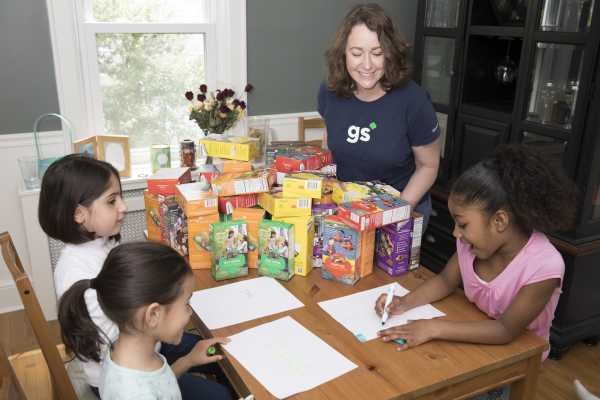
“All of the net revenue from cookie sales — 100 percent of it — stays within a Girl Scout council’s local area to benefit girls and their council,” a Girl Scout rep assured Bustle. The proceeds are split between the council — which funds things like summer camps and adult volunteer trainings, as well as coveted cookie-selling prizes — and the particular troop, where it goes toward activities and projects. A common model is “spend a little, save a little, share a little,” Goodbody told me. Making these decisions as a group is an important part of the process.
How exactly the profits get divided is again up to the regional council, but for a case study, let’s turn to the Girl Scouts of Western Pennsylvania, who break down their financials like this:
- 50 percent goes to council-sponsored programs, events, properties, training, and scholarships.
- 24 percent goes to the cost of the cookies.
- 23 percent goes to troop proceeds, girl recognitions, and service unit bonuses.
- 3 percent goes to the cost of Cookie Program support.
Managing inventory is important. The logistics of ordering cookie stock — taking preorders versus buying cookies in advance to have ready on the spot — is a science and an art. There are door-to-door sales. There are booth sales, where troops set up cookie pop-ups at well-traversed locations. (Would you like to find a booth near you? The Girl Scouts have an app for that.) There are sales online.
Troops buy the stock they sell — if a girl has boxes to sell, she or her family bought those boxes — which means it is key to actually sell them. What to do with unsold cookies is a popular topic on parental message boards.
It’s not just about the cookies
“I can say this until I’m blue in the face,” Goodbody tells me, “but it’s about so much more than cookies.” She points out that more than half of “female entrepreneurs and business owners are Girl Scout alums,” according to data from the Girl Scout Research Institute. In the 2018 midterms, she notes, “the majority of females” elected to Congress were Girl Scouts once.
“This is the first career move for millions of girls,” she says. For a 5- or 6- or 7-year-old, it’s a big deal to feel in control of anything, given that, at 5 or 6 or 7, you aren’t even in control of when you go to bed. “People are telling you what to do all the time and here you are handling money and deciding where that money is going to go and figuring out how to market yourself and your product to customers.”
The Girl Scouts’ official materials credit cookie sales for instilling girls with five essential skills: goal-setting, decision-making, money management, people skills, and business ethics. “Don’t take ‘no’ for an answer, push ahead and see the bigger picture,” says Katelyn, a “cookie entrepreneur” quoted on the site.

“Selling cookies is usually a girl’s first exposure to the world of business,” Frances Hesselbein, then the national executive director of the Girl Scouts, told the New York Times. “She learns how to meet the public, talk about a product, sell the product and is responsible for collecting money, giving change and delivering the product. That’s quite a business venture for a 7-year-old.’’
In the Washington Post, Kelly Richmond Pope, once a scout, now a professor of forensic accounting, recalls “long weekends of walking door to door with my parents, working on my ‘cookie elevator pitch’ in between houses. I knew which houses were easy sells and which were tougher. I didn’t realize at the time that I was learning marketing strategy in addition to sales.” She goes on to credit selling cookies with teaching her “how to resist the temptation to embezzle” — a great lesson for us all! — to set realistic goals, and to take responsibility for her work.
“I want to be a neurosurgeon,” Miranda, a 15-year-old scout from Brooklyn, told Fortune between cookie transactions. “As a girl scout, I am able to execute a plan, so when I’m a neurosurgeon and I want to get into the brain, I have to execute a plan.”
“When you know how to sell something, you’re kind of set for life”
Is there something perhaps vaguely sinister about celebrating the sixth-grader who put in “11-, 12-, 13-hour days” peddling cookies? With all due respect: yes. Would it be nice to have a group organization for girls that did not lean quite so heavily on building character by selling things on behalf of a major corporation? Also yes. At the same time, the cookie program is excellent preparation for the world that actually exists. “When you know how to sell something, you’re kind of set for life,” Goodbody says. It is hard to argue.
Of course, all this hinges on one important detail: The girls have to be the ones actually doing the selling. Except that if you are a person who works in an office with adults, you know this is not always how it goes.
“You already know exactly how this happens. You’re sitting at your desk, or pushing your cart through the grocery store, thinking about spring, when a sheepish parent sidles up — and he’s not even wearing a Girl Scout uniform. The next thing you know, you’ve agreed to take delivery of three boxes of Trefoils,” lamented KJ Dell’Antonia in the New York Times. “It’s a freaking racket,” one Colorado mom told Thrillist. “I have to say, I kind of dread Girl Scout Cookie season. It’s a lot of work for me!”
The Girl Scouts, for their part, do not condone this practice. “A girl,” Goodbody says, “is always supposed to initiate the sale.” According to the organization, delegating your parents to foist cookies on their colleagues does not constitute “executing a plan.”

Fears about losing the program’s educational edge led the Girl Scouts to question launching sales online. But for the 2015 season, Girl Scouts of the USA launched the “Digital Cookie” platform, which allows online sales (teaching “vital entrepreneurial lessons in online marketing, application use, and e-commerce”). The twist is that you can only buy cookies through a scout’s personal cookie website. And to access it, a potential customer needs a digital invitation from a participating Girl Scout, which means you need a connection to an actual Girl Scout, perhaps because you are related to her. (Girl Scouts are not supposed to pass out their cookie URL to strangers, for safety reasons.)
There is one tiny loophole in the system: Amazon. But while you can technically buy them online, without interacting with a single girl, the Girl Scouts of the USA would strongly prefer you do not.
Girl Scout cookies are a comforting tradition
Girl Scout cookies do have detractors. Besides exasperated scout parents, there are health advocates who object to the cookies, on the grounds that they’re cookies. “Girl Scout cookies are just another sign of the problem of hyperconsumption,” pediatric endocrinologist Robert Lustig told NPR. “This is just another part of this toxic food chain that kids are awash in,” Susan Rubin, a dentist turned nutritionist and former troop leader, told the New York Times. “At some point, communities are going to have to walk away from the Do-Si-Dos.”
But we haven’t. People love Girl Scout cookies. Part of that is the taste; they are eminently edible, because they are cookies. Part of that is the nostalgia. They remind you of childhood, how you once were a scout, or knew a scout, or ate cookies. They are simple and pure.
“The Girl Scout cookie is a piece of Americana,” Goodbody says. There is a picture in the Girl Scout archives of Grace Coolidge eating Girl Scout cookies on the White House lawn.
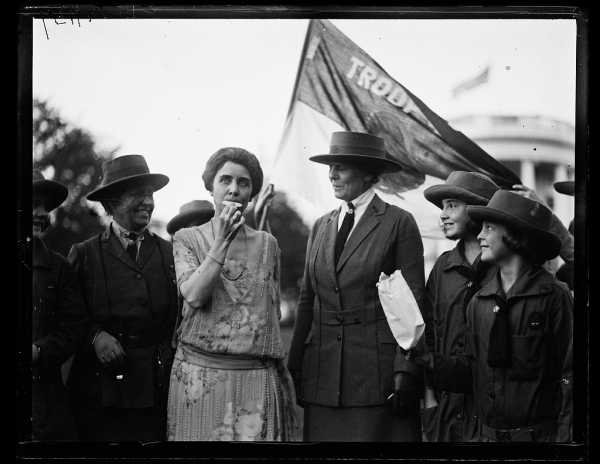
They are also pleasantly limited. “Girl Scout cookies only come around once a year,” Harry Balzer, a national food expert at the NPD Group research firm, told USA Today, “and they’re very much like Halloween is to candy and Thanksgiving is to turkey.”
To Goodbody, a big part of the appeal is civic-minded: People want to support the girls themselves. “You want to her to succeed, and you want to respond in a way that’s going to build her skills so that she’s confident and continues to take that risk and knock on the next door.”
Girl Scout cookies are not the best kind of cookies. But it doesn’t matter, because they serve an important social function: They give us all a high-minded excuse to do the thing we all already want to do — buy and eat cookies.
Want more stories from The Goods by Vox? Sign up for our newsletter here.
Sourse: vox.com






